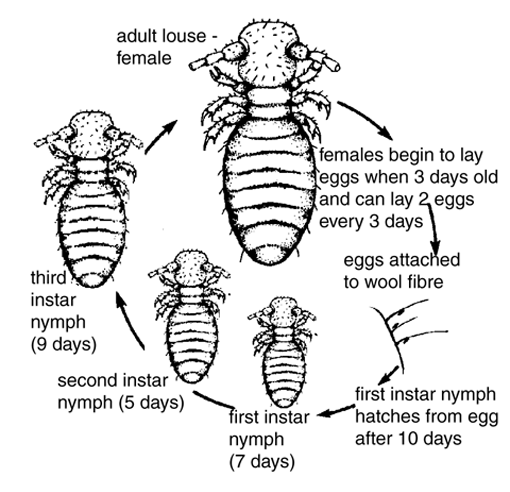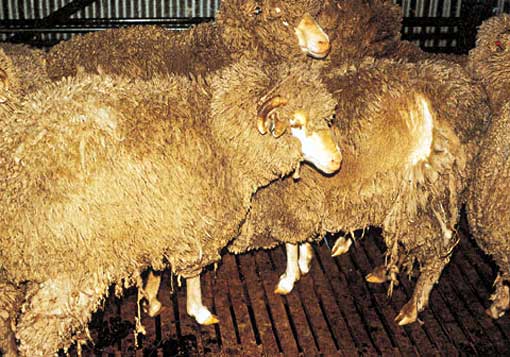AMR HASSAN
Admin


العمر : 35
الكلية : كلية الطب البيطري
الفرقة : الرابعـــــــــــــــــــة
السكشن : 5
تاريخ التسجيل : 16/01/2009
 |  موضوع: Sheep Lice موضوع: Sheep Lice  6/4/2009, 5:27 pm 6/4/2009, 5:27 pm | |
| السلام عليكــم ورحمـة الله وبركاتــة ،،
بســم الله الـرحمــن الرحيــم
Sheep lice
Three species of lice infest sheep in NSW. They are the foot louse, Linognathus pedalis, the face louse, Linognathus ovillus and the sheep body louse, Bovicola ovis. Face lice and foot lice rarely cause a major problem. However, the sheep body louse remains a common and costly pest to wool production.

==================
The sheep body louse
Description
Adult sheep body lice are about 1.8mm long and about 0.6mm wide. They have a broad reddish head and a pale brown abdomen with slightly darker brown stripes. Most lice are usually found near the skin.
Female lice lay two eggs every three days. The eggs are white, microscopic in size, and are attached to the wool fibre usually within 6-12mm of the skin. Immature lice - nymphs - hatch from the eggs after about 10 days. There are three nymphal stages or instars, which occupy seven, five and nine days respectively. The third instar nymph moults to an adult louse.
Females reach egg laying maturity within four days of moulting. Lice spend their entire life on the skin or wool of sheep. The minimum length of the life cycle is about 34 days. Female lice live about 27 days and males about 48 days. However, there are reports of lice surviving for over 120 days.

=-======================
How body lice affect sheep
Lice feed on dead skin, secretions and bacteria normally found at the surface of the skin. They do not suck blood. They do not eat the wool fibres but do cause a thickening of the skin.
Their presence irritates the sheep, causing the sheep to bite, scratch and rub on trees and fences. This damages the wool, causing breakage and cotting of the fibres. Sheep infested with lice have a ragged appearance - often with tags of wool hanging from the fleece.
Newly infested sheep are very sensitive to lice. Others, which have had lice for long periods, can develop quite severe infestations but show few signs.
Often lousy wool has a yellow colour due to a heavy suint and skin secretions and shearers claim it has a distinctive smell.
Sheep with a comparatively light lice infestation

Stock with a heavy infestation

=================
Treatment
It costs money, time and effort to muster sheep and treat them with one of the chemicals available for lice eradication - around $2 per sheep per year, accounting for fixed and variable costs, demands attention to detail to ensure effective treatment and to reduce the risk of sheep deaths due to treatment, introduces chemical residues to the fleece that are not wanted by wool customers, poses a potential Occupational Health and Safety risk to the operators. Costs to be incurred in training, possible modification of treatment equipment, provision of personal protective equipment, health checks and training for those involved in treatment and insurance to cover workers compensation.
Faulty application of insecticides is the most common cause of failure to eradicate lice. There are many reasons for faulty application. Following the recommendations for treatment and control in this Agfact will reduce the risk of treatment failure.
How to find lice
If lice are suspected, examine sheep that show signs of wool derangement. Lice are often most numerous on sheep that are not doing well. If you need glasses to read, you will need them and good lighting to see lice. A policy of regular inspection of sheep for lice and recording the findings is best. Lice congregate in colonies and may be missed if the wool is only opened at one or two places. Select at least 10 sheep showing some signs of fleece derangement or those sheep at the tail of the mob. Examine at least five sites on each side of at least 10 sheep.
Record your findings so that subsequent inspections can be compared. If no lice are seen, then either look at another 10 sheep or reinspect the flock in 3-4 weeks.
Lice in small numbers are extremely difficult to find on sheep. At least 400 to 500 lice per sheep must be present before they can be detected by inspection of unshorn sheep. Inspections can be carried out any time sheep are yarded and especially at crutching and shearing. The best time to see lice is during, or immediately after shearing. Pay particular attention to the neck folds and longer wool on the neck. In woolly sheep, lice can be found anywhere along the side, neck, back and rump.
It is important to remember that the visual wool damage due to lice depends:
not only on the number of lice, but also on, the sensitivity of sheep to lice, and the length of wool.
Wool damage is usually not obvious until there is at least three months growth of wool and a significant number of lice.
Early identification of the problem allows time to plan treatment strategies. A test which uses the greasy debris that accumulates on the comb and cutter of the shearers' handpiece during shearing to detect louse proteins, is under development. As well as identifying lousy flocks the test should be able to confirm freedom from lice. This will give woolgrowers greater confidence in choosing not to treat sheep on the suspicion that they may be lousy. Until the test becomes available, however, visual assessment remains the best method for diagnosis.
Remember, if one louse is found on one sheep in a mob, then the whole mob is considered lousy.
88888888888888888888888888888888888888888888888
بعض اضافات
د

Nits are head lice eggs. They are hard to see and are often confused for dandruff or hair spray droplets. Nits are laid by the adult female and are cemented at the base of the hair shaft nearest the scalp. They are 0.8 mm by 0.3 mm, oval and usually yellow to white. Nits take about 1 week to hatch (range 6 to 9 days). Viable eggs are usually located within 6 mm of the scalp
========================
Head Lice: Nymph hatching through the operculum of an egg. The egg hatches releasing a nymph. The nit shell then becomes a more visible dull yellow and remains attached to the hair shaft. The nymph looks like an adult head louse, but is about the size of a pinhead. Nymphs mature after three molts and become adults about 7 days after hatching.

==============
Head Lice: Adult louse and two nymphs. The adult louse is about the size of a sesame seed, has 6 legs (each with claws), and is tan to grayish-white. In persons with dark hair, the adult louse will appear darker. Females lay up to 8 nits per day. Females are usually larger than males

===============
Pediculis humanus var. capitis adult and egg (nit) on hair shaft
 تم تقليل : 55% من الحجم الأصلي للصورة[ 923 x 611 ] - إضغط هنا لعرض الصورة بحجمها الأصلي تم تقليل : 55% من الحجم الأصلي للصورة[ 923 x 611 ] - إضغط هنا لعرض الصورة بحجمها الأصلي

Female head louse, Pediculus humanus var capitis
 تم تقليل : 73% من الحجم الأصلي للصورة[ 695 x 473 ] - إضغط هنا لعرض الصورة بحجمها الأصلي تم تقليل : 73% من الحجم الأصلي للصورة[ 695 x 473 ] - إضغط هنا لعرض الصورة بحجمها الأصلي
====================
Head Louse on Human Hair - Pediculus humanus capitis

=============================
Head Louse on Human Hair - Pediculus humanus capitis

==========
Head Louse Egg Case on a Human Hair, Pediculus humanus capitis

| |
|
fathya
فيتاوي جديد

العمر : 35
الكلية : الطب البيطرى
الفرقة : الثالثة
السكشن : السادس
تاريخ التسجيل : 17/04/2009
 |  موضوع: رد: Sheep Lice موضوع: رد: Sheep Lice  18/4/2009, 3:53 am 18/4/2009, 3:53 am | |
| | |
|
